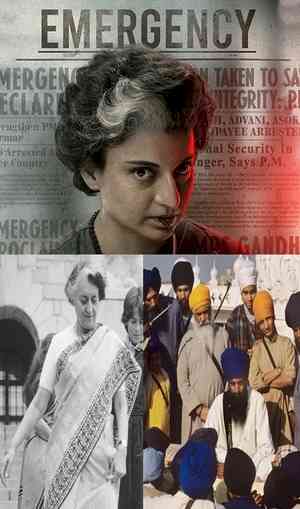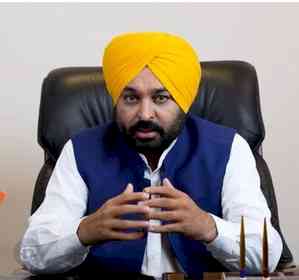Bhindranwale, Congress, and Khalistan: Why Kangana's 'Emergency' faces Sikh ire
The Emergency is still a controversial issue in the Indian polity, and sparks are bound to fly when a controversy-courting actor like Kangana Ranaut seeks to present it onscreen. However, the film's release has been stuck as various Sikh organisations across the country, including the SGPC, take umbrage over the depiction of the community and the Punjab troubles.

Vikas Datta
New Delhi, Sep 6 (IANS) The Emergency is still a controversial issue in the Indian polity, and sparks are bound to fly when a controversy-courting actor like Kangana Ranaut seeks to present it onscreen. However, the film's release has been stuck as various Sikh organisations across the country, including the SGPC, take umbrage over the depiction of the community and the Punjab troubles.
There has no been love lost between Kangana and (Sikh) Punjab, with her remarks on the farmers' protests and the assault on her by a woman CISF trooper, hailing from the state, at an airport and some references to Punjab in the film trailer have added to the toxic mix.
The purported depiction of militant preacher Jarnail Singh Bhindranwale, and his reported deal with the Congress to ensure support and votes in exchange for 'Khalistan', and a montage scene showing one of the massacres by Khalistani militants has riled up the community.
While there is no conclusive proof that Bhindranwale was a votary of Khalistan, with the furthest he went being opining, ahead of Operation Blue Star as he barricaded himself in the Sri Harmandir Sahib and security forces began the siege, that the "foundations of Khalistan will be laid the day the Indian Army storms the Golden Temple", there are questions why a film based on the Emergency (1975-77) deals with the Punjab problem, which technically only erupted in 1978 with the anti-Nirankari movement.
The reality lies somewhere in the middle. While Bhindranwale may never have explicitly espoused Khalistan, his actions were geared towards this direction and there was a tacit, but short-lived, agreement between him and the Congress before it ended in acrimony in 1981.
Why this happened, necessitates a look into the political history of Punjab since Independence, particularly the reasons for the emergence of Bhindranwale.
Following the horrors of Partition, the Sikhs, left bereft of some of their most productive land and property, as well as key shrines such as Kartarpur Sahib and Panja Sahib, began demanding a 'Punjabi Suba', with Master Tara Singh raising the demand right from 1948.
Partitioned East Punjab then included what is now Haryana and parts of Himachal Pradesh.
The 'Punjabi Suba' movement, spearheaded by the Akali Dal, encountered resistance from some Hindu outfits, who even took out ads in newspapers, ahead of the Census, asking co-coreligionists to cite Hindi, not Punjabi, as their mother tongue, to dilute the demand.
For the next decade and a half, the movement saw much drama, including a police raid on the Golden Temple in 1955, mass arrests of the Akalis, and fasts by Tara Singh and Sant Fateh Singh. Eventually, the Punjab Suba demand conceded in 1966, but agitation had created a communal rift, whose dire consequences would be seen in the decades to come. Sikh activist Darshan Singh Pheruman did fast to death in jail in 1969 over the non-transfer of Chandigarh and other Punjabi-speaking areas.
The next flashpoint came in 1973 with the Akalis passing the Anandpur Sahib Resolution demanding more powers for the states. The trigger was the destabilisation of the party's first government in the state, led by Justice Gurnam Singh (retd). It came to power in February 1967 but fell in November that year, as a section of legislators led by Lachman Singh Gill walked out. Gill would go on to become Chief Minister with the support of the Congress, but lasted only a few months.
The Anandpur resolution would go on to bedevil Centre-State relations for the next two decades and fuel the rise of terrorism, as some vested interests seized the issue to seek a Sikh homeland. Meanwhile, charismatic preacher Bhindranwale entered the stage.
The Congress had intended him to against the Akalis, but his ascendancy was fuelled by the feud between two tall Congress leaders and Chief Ministers -- Darbara Singh and Giani Zail Singh (later President). One used the fiery preacher to weaken his rival, but in the process created an unpredictable and uncontrollable force. And when Bhindranwale latched on to the Khalistan demand and the ongoing Sikh-Nirankari tussle, he had become too big to control.
Full-blown violence erupted in the early 1980s - the murder of the Hind Samachar Group's Lala Jagat Narain and Punjab Police DIG A.S. Atwal within the Golden Temple, extortions, bombings, and random massacres.
With Bhindranwale's demands getting more strident and his open defiance of the state, Operation Blue Star was launched in June 1984. Though Bhindranwale and his top aides were killed, the damage to the Sikh's shrine and growing anger, led to the assassination of Prime Minister Indira Gandhi, and a full-blown insurgency in the state, finally quelled in 1992.
However, Bhindranwale's time was well after the Emergency, and he and the Congress eventually ended up fierce enemies.
(Vikas Datta can be contacted at [email protected])
--IANS
vd


 IANS
IANS 










